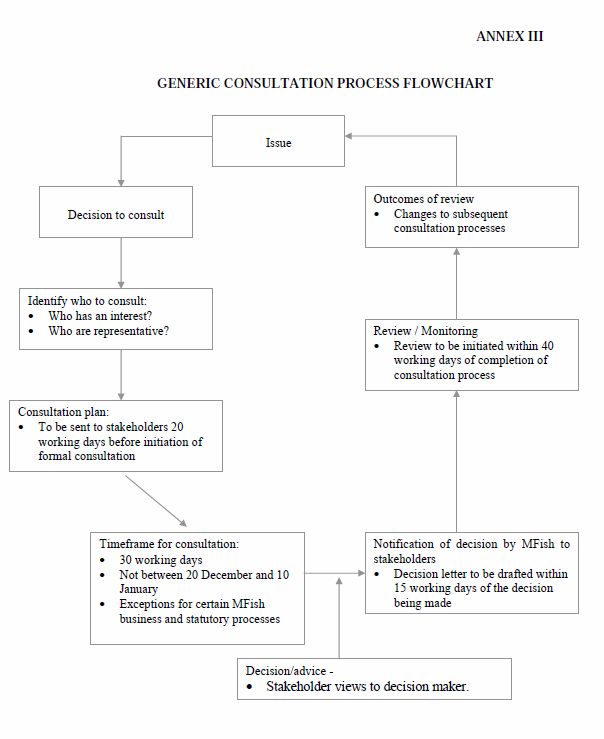Environmental Strategy, Standards and National Plans of Action
In order to help address the environmental impacts of fishing activity, the former Ministry of Fisheries prepared a report in 2005 titled “Strategy for managing the environmental effects of fishing”. 0b6cc3ed-4252-492f-a523-3a1c0c47f2aa The core approach adopted in the strategy was the development of environmental standards to specify the limits of acceptable effects of fishing on the aquatic environment. Such standards have no statutory force, but are used as a guide to decision-making under the Fisheries Act. The following standards have been prepared: dc848fac-e355-4fb5-999e-d4c2a9eb91ab
- Harvest Strategy Standard 2008 – Discussed further below
- Stakeholder Consultation Process Standard 2009 (draft) - Outlines how stakeholders will be consulted during decision-making – which is shown in the figure below.
- Identification of Candidate Stocks for QMS Introduction (2008) (draft) – Defines the process for introducing new fisheries into the QMS
- Research and Science Information Standard 2011 – Focuses on the delivery of high quality research and science to inform fisheries management

The Harvest Strategy Standard, finalised in October 2008, provides guidance for the setting of the target sizes for fish stocks. It contains three core elements: A specified target about which a fishery or stock should fluctuate; a soft limit that triggers a requirement for a formal, time-constrained rebuilding plan; and a hard limit below which fisheries should be considered for closure. The Operational Guidelines for New Zealand’s Harvest Strategy Standard (Revision 1) was prepared in June 2011 to support the implementation of the Harvest Strategy Standard. eadfea5d-d1d9-4723-bcee-4f5a8edc06b2 This document includes guidance on calculating biological reference points which assist with setting fishing targets that form the basis for the default limits specified in the Standard.
Much of the work on Standards has now been superseded by National Plans of Action. For example, the National Plan of Action Seabirds 2013 sets out a number of long-term objectives for the next five years with the goal of reducing the seabird interactions with the fishing industry. These are broken down into practical, biological risk and research and development objectives, both on a high level and five-year basis, and include the following examples:
74ab37d4-5e60-478f-b15f-aaa570f79b07
- “The level of mortality of New Zealand seabirds in New Zealand commercial fisheries are reduced so that species currently categorised as at very high or high risk from fishing move to a lower category of risk.”
- “Where existing mitigation measures are impractical or of limited effectiveness in reducing the mortality of New Zealand seabirds, new or improved mitigation measures have been sought and where identified are under development for all priority fisheries or fishing methods…”
The development of this National Plan of Action has been a collaborative effort involving the Ministry for Primary Industries, the Department of Conservation, the fishing industry, tangata whenua and environmental groups. A risk assessment approach is being used to guide management priorities, an online database provides more detail about seabird captures, and an advisory group monitors the implementation of the Plan.
-
Ministry of Fisheries, 2005
-
http://www.fish.govt.nz/en-nz/Consultations/Under+Review/Fisheries+Standards/default.htm
-
http://fs.fish.govt.nz/Doc/22847/Operational_Guidelines_for_HSS_rev_1_Jun_2011.pdf.ashx
-
http://www.fish.govt.nz/en-nz/Environmental/Seabirds/default.htm?WBCMODE=PresentationUnpublished%23MainContentAnchor%23MainContentAnchor
Last updated at 4:19PM on November 23, 2017